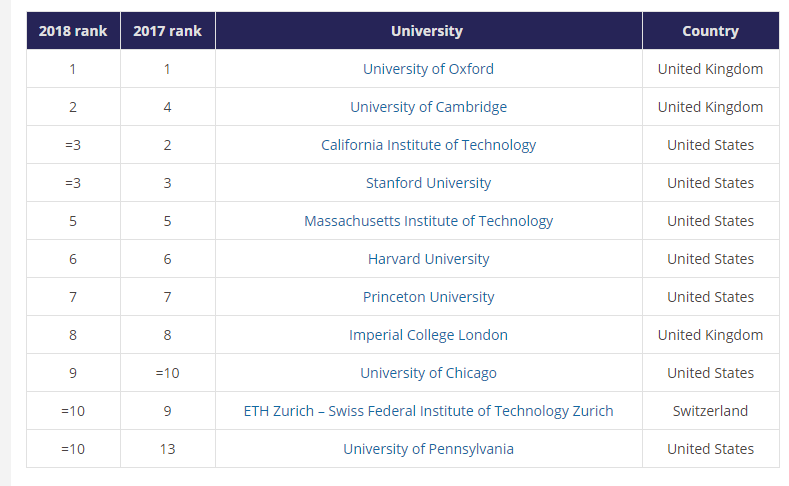Times Higher Education (THE) has released its World University Rankings 2018. As one of China’s flagship universities, Peking University has risen two places to joint 27th while Tsinghua University moved up five to 30th.
Founded in 1898, Peking University was originally known as the Imperial University of Peking. It was the first national university covering comprehensive disciplines in China, and has been a leading institution of higher education in China since its establishment. Peking University is a member of the C9 League, analogous to the Ivy League in the United States, and often ranked among the top higher education institutions in China. Only those who score highest in nationwide examinations are admitted, with a total enrollment of about 35,000.
Two UK institutions lead THE ranking of the best universities for the first time in its history, with Oxford holding on to the number one spot for the second year in a row, while Cambridge has risen to second place.

Cambridge’s rise comes at the expense of the California Institute of Technology, which was number one between 2012 and 2016, number two last year, and now shares third position with Stanford.The US universities’ institutional income also dropped by 23 per cent and 24 per cent, respectively, while Cambridge and Oxford each received a boost in revenue (by 11 per cent and 24 per cent, respectively).
Indeed, the continuing rise of Asia is one of the main themes of this year’s ranking. The continent’s leading institution, the National University of Singapore, claims its highest position ever, joint 22nd place (up from 24th).Peking University has risen two places to joint 27th while Tsinghua University moved up five to 30th.
Meanwhile, mainland China is now the joint sixth most-represented nation in the top 200. It has seven universities in this elite group, three more than last year, overtaking Hong Kong (with five top 200 institutions) as Asia’s most successful territory at the top of the ranking.
Peking University is a member of the C9 League, analogous to the Ivy League in the United States, and often ranked among the top higher education institutions in China. Only those who score highest in nationwide examinations are admitted, with a total enrollment of about 35,000.
In 1898 the then Imperial University of Peking was founded as the first national university covering comprehensive disciplines in China, replacing the ancient imperial academy which had for hundreds of years trained administrators for China’s civil service.
When China became a republic in 1912 the university took on its current name. Its 274 hectare campus sits in Beijing’s Haidian District, near the famous Yuanmingyuan Garden and Summer Palace, and is known as known as ‘Yan Yuan’ or ‘the garden of Yan.’
The rise of Asian universities has been a constant refrain in global higher education over the past few years, but which areas of academic activity are key to the progress they are making?
These “waterfall” diagrams, based on the average scores for different countries in each of the 13 metrics underlying the Times Higher Education World University Rankings and drawn from THE’s DataPoints analytical tools, may begin to explain the reasons.
As well as the change in the country average for overall rankings scores between 2017 and 2018 (in blue), the red and green blocks show – in order of magnitude – how each metric contributed to that change.
An improvement in citation performance jumps out as being the crucial marker for those, such as China and India, on a large upward curve, with higher income per staff scores and, to a lesser extent, growing internationalization also contributing to their advancement. China is also seeing improvements on research feeding through into higher reputation scores.
One slight drag on the performance of both countries is a drop in staff-to-student ratio scores.
On the other side of the coin, the rise of such countries is helped by the slower pace of growth, or in some cases backward steps, among universities in the West.
From
Times Higher Education
By Ellie Bothwell, Jack Grove and Simon Baker